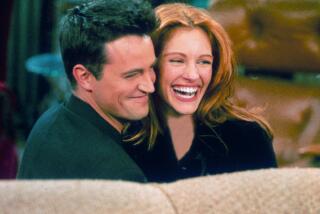‘Roseanne’ minus Roseanne? Nine other shows that soldiered on without their star
- Share via
The show must go on? That appears to be the sentiment in the days since ABC suddenly canceled “Roseanne” after star and co-creator Roseanne Barr made a racist statement on Twitter. It was a stunning reversal of fortunes for a revival that became one of the biggest broadcast hits of the 2017-18 season and a devastating blow to the nearly 400 people employed by the show.
However, a glimmer of hope has since emerged for those 400 newly unemployed actors, writers and crew members in the form of a potential “Roseanne” spinoff said to involve executive producers Tom Werner and Sara Gilbert (and that would cut Barr out completely, both creatively and financially).
But can there be a “Roseanne” without, well, Roseanne? The Times decided to take a look back at other major TV shows and how they fared after losing their star.
READ MORE: Los Angeles Times readers weigh in on ‘Roseanne’ without Roseanne »
Kevin Spacey, “House of Cards”
When the two-time Oscar winner (“The Usual Suspects”,” “American Beauty”) was first hit with sexual misconduct allegations by “Star Trek: Discovery” actor Anthony Rapp, Netflix immediately suspended production on the sixth season of its political drama to assess the situation. The allegations continued to mount, and days later, the company cut all ties with its leading man, throwing out the scripts and starting from scratch without Spacey’s character, Frank Underwood. The streaming service later confirmed that the upcoming sixth season would be its last.
Valerie Harper, “Valerie”
The closest comparison to ABC’s “Roseanne” debacle might be this ’80s family sitcom, in which the former “Mary Tyler Moore” star played a working mother of three. After the series became more popular in Season 2, Harper asked for a raise and a bigger cut of the show’s syndication revenue. When she was denied, she went on strike for one episode. A compromise was reached, but weeks later, producers claimed Harper walked off, while she claimed she was fired.
Harper’s character was killed off in a car accident and Sandy Duncan was brought in as the children’s aunt/pseudo new mother figure. The series was re-named “Valerie’s Family.” Lorimar then sued Harper for $70 million, claiming breach of contract. Harper counter-sued for $180 million and, as part of her suit, demanded that the show stop using her name. At the end of Season 3, the name was changed again — this time to “The Hogan Family.”
Three months later, Harper won her wrongful termination suit and was awarded $1.4 million in lost wages. Despite decent ratings, NBC opted not to renew the show for a sixth season. The series then moved to CBS. However, the show stumbled in the ratings and was pulled off CBS’ schedule. Production was halted after just four months. The final episodes aired the following summer in July 1991.

Charlie Sheen, “Two and a Half Men”
After finishing his third rehab stint in a year, the then-highest paid actor on television got himself in hot water when he made derogatory comments about series creator Chuck Lorre. He was subsequently banned from the Warner Bros. lot, and CBS canceled the remaining four episodes of the season. He then publicly demanded a 50% raise, at which time he was fired and replaced with Ashton Kutcher, who joined the comedy as a new character who buys the house that formerly belonged to Sheen’s Charlie Harper. (Sheen filed a wrongful termination lawsuit, which was later settled.)
“Two and a Half Men” lasted four more seasons, although the show never found the same success as it had with Sheen. In the later years, the series killed off Charlie not once but twice, first when he was said to have been struck by a train and the second when it was discovered he was actually alive only to have a piano dropped on him. (In between those, the ghost of Charlie Harper was played by Kathy Bates, who won an Emmy for her portrayal.)
Suzanne Somers, “Three’s Company”
Many small screen actresses went to extremes in demanding higher salaries in the ’70s, but not all were successful. While Valerie Harper successfully staged a strike on “Rhoda” for more money, the breakout star of “Three’s Company” was not so lucky. At the beginning of Season 5, Somers asked for a big salary bump from $30,000 to $150,000 an episode as well as 10% ownership of the show’s profit. ABC refused, and Somers skipped the second and fourth episodes of the season.
ABC and producers retaliated again, cutting her screen time down to just 60 seconds per episode when it was written that her character, Chrissy, had moved back to her parents’ house. ABC then terminated her contract at the end of the season and she sued for $2 million, claiming damage had been done to her reputation. In the end, she was awarded just $30,000. On the series, Somers was replaced first by Jenilee Harrison, who played Chrissy’s cousin, and then by Priscilla Barnes in Season 6. The series lasted eight seasons, before star John Ritter segued to his own short-lived spinoff, “Three’s a Crowd.”
Shannen Doherty, “Beverly Hills, 90210” and “Charmed”
Doherty has the unique distinction of leaving two series early in their run. On “Beverly Hills, 90210,” Doherty skyrocketed from unknown to teen idol with her series character, Brenda. However, her bad behavior on the show drew headlines. “I was not the most diplomatic person,” she told Entertainment Weekly about the first season.
At the end of Season 4, she and the show parted ways when Brenda went off to London for drama school. Tiffani Thiessen was brought on to replace Doherty, in the role of the Walsh twins’ troubled family friend from Buffalo, and the series wound up running another six seasons — longer than Doherty’s tenure.
A decade later, Doherty reunited with “Beverly Hills” executive producer Aaron Spelling for the WB witch drama “Charmed,” in which she played one of three sisters who all discover they are witches. However, she departed again at the end of Season 3, at which point she was replaced by Rose McGowan. (Star Alyssa Milano hinted that bad blood between the cast played a role when she appeared on “Watch What Happens Live” in 2013, when she alluded to “rough days” on set during Doherty’s tenure and compared the set to “high school.”) Once again, the series wound up producing more seasons without Doherty than her, lasting eight seasons total.
Cindy Williams, “Laverne & Shirley”
The iconic TV duo was split in half at the beginning of the sitcom’s eighth season when Williams revealed she was pregnant. She asked for special accommodations on set during her pregnancy, but when Paramount refused, she left after the second episode and filed a $20-million lawsuit against the studio. (The suit was later settled out of court). Onscreen, producers wrote her out via a whirlwind romance with an Army medic whom she married and then had to follow overseas. In her final scenes on the series, Shirley discovered she was pregnant.
Ratings remained solid despite Williams’ sudden exit, but the show was quietly canceled at the end of its eighth season when star Penny Marshall would agree to return for a ninth season only if production moved to New York. The series finale served as a backdoor pilot for supporting character Carmine (Eddie Mekka), but the project was never picked up to series.
John Ritter, “8 Simple Rules for Dating My Teenage Daughter”
Ritter starred as an overprotective stay-at-home dad in the first season of the ABC family sitcom, which marked his first series regular role in more than 15 years. But a few weeks into production on Season 2, Ritter began suffering chest pains during rehearsals and was rushed to the hospital. Doctors misdiagnosed his aortic dissection as a heart attack and he died during surgery several hours later. ABC aired Ritter’s remaining episodes, and his character in the series was subsequently also killed off after suffering an aortic dissection.
The show’s title was then changed to simply “8 Simple Rules”; James Garner and later David Spade were brought on as series regulars, and the show shifted to following the fictional Hennessy family as navigated their grief. However, the half-hour took a ratings dive in its third season and was eventually canceled.
Mackenzie Phillips, “One Day at a Time”
Trouble began in the Norman Lear sitcom’s third season when Phillips, who played Julie Cooper, the wild child teenage daughter of single mom Ann Romano (Bonnie Franklin), was arrested for disorderly conduct. Her drug and alcohol abuse soon became apparent when she showed up late and/or incoherent to rehearsals and began suffering side effects, such as extreme weight loss and chronic hoarseness. Two years later, producers ordered her to take a six-week break (when her character tied the knot and moved to Texas), but soon after she returned, she was fired from the series in February 1980.
When Phillips completed treatment in 1981, producers welcomed her back. However, she began using drugs again the following year and collapsed on the show’s set. She was fired for the second and final time. Her character was written out of the series at the beginning of Season 9, which was later confirmed to be its final season. Nearly four decades later, Phillips appeared on Netflix’s “One Day at a Time” reboot as a counselor.
Danny Masterson, “The Ranch”
In addition to “House of Cards,” Netflix was forced to clean house on its multicam comedy “The Ranch” after four women’s rape allegations made against star and executive producer Masterson resurfaced in the height of the #MeToo movement. Although Masterson denied the allegations, Netflix announced in December 2017 that the actor would exit the comedy after the first half of Season 3.
It remains to be seen just how he’ll be written out, but Netflix subsequently brought on Dax Shepard to recur in the second half of the third season, as a soldier who becomes friendly with Ashton Kutcher’s character, Colt (the brother of Masterson’s character).
More to Read
The complete guide to home viewing
Get Screen Gab for everything about the TV shows and streaming movies everyone’s talking about.
You may occasionally receive promotional content from the Los Angeles Times.







